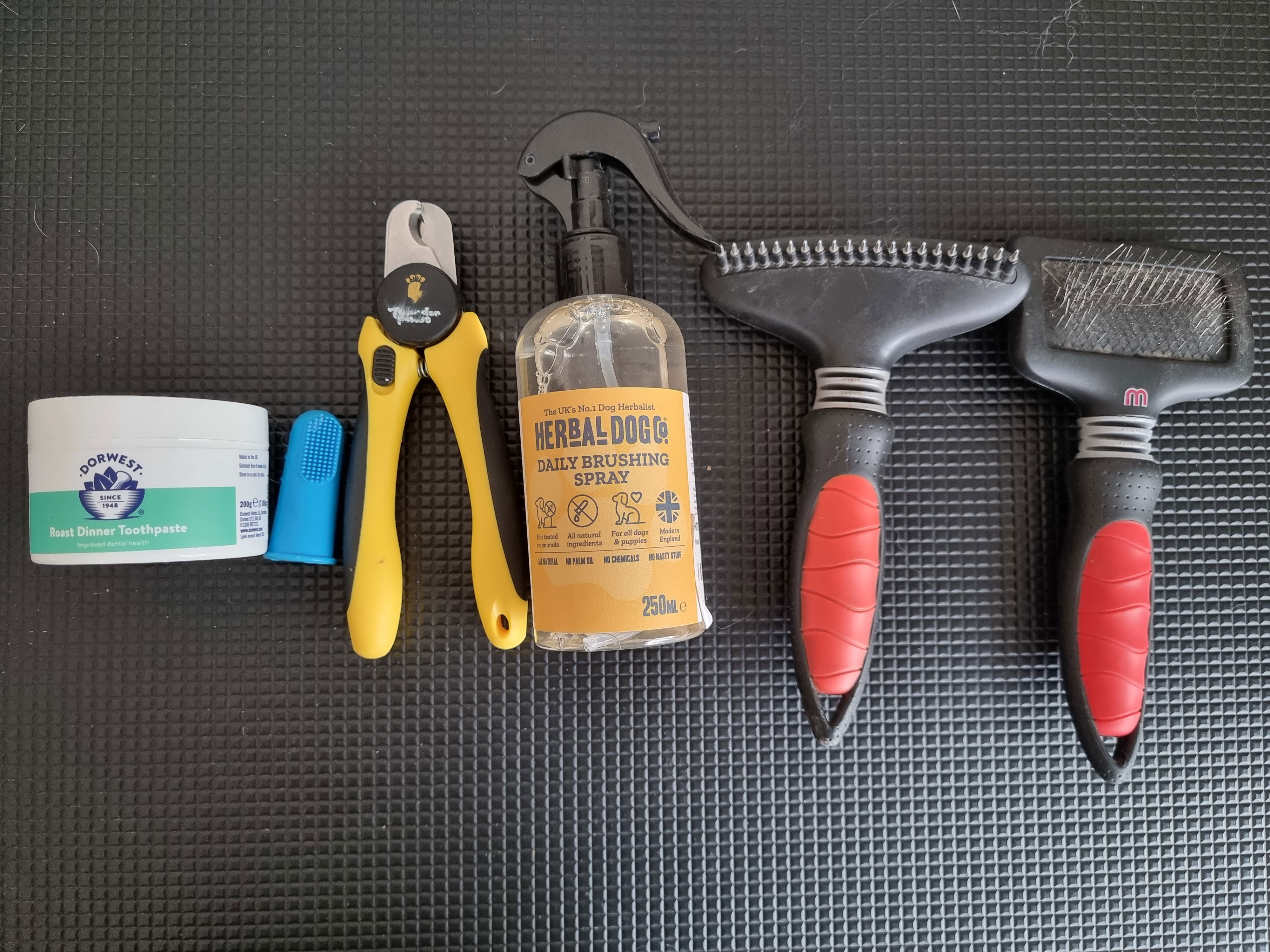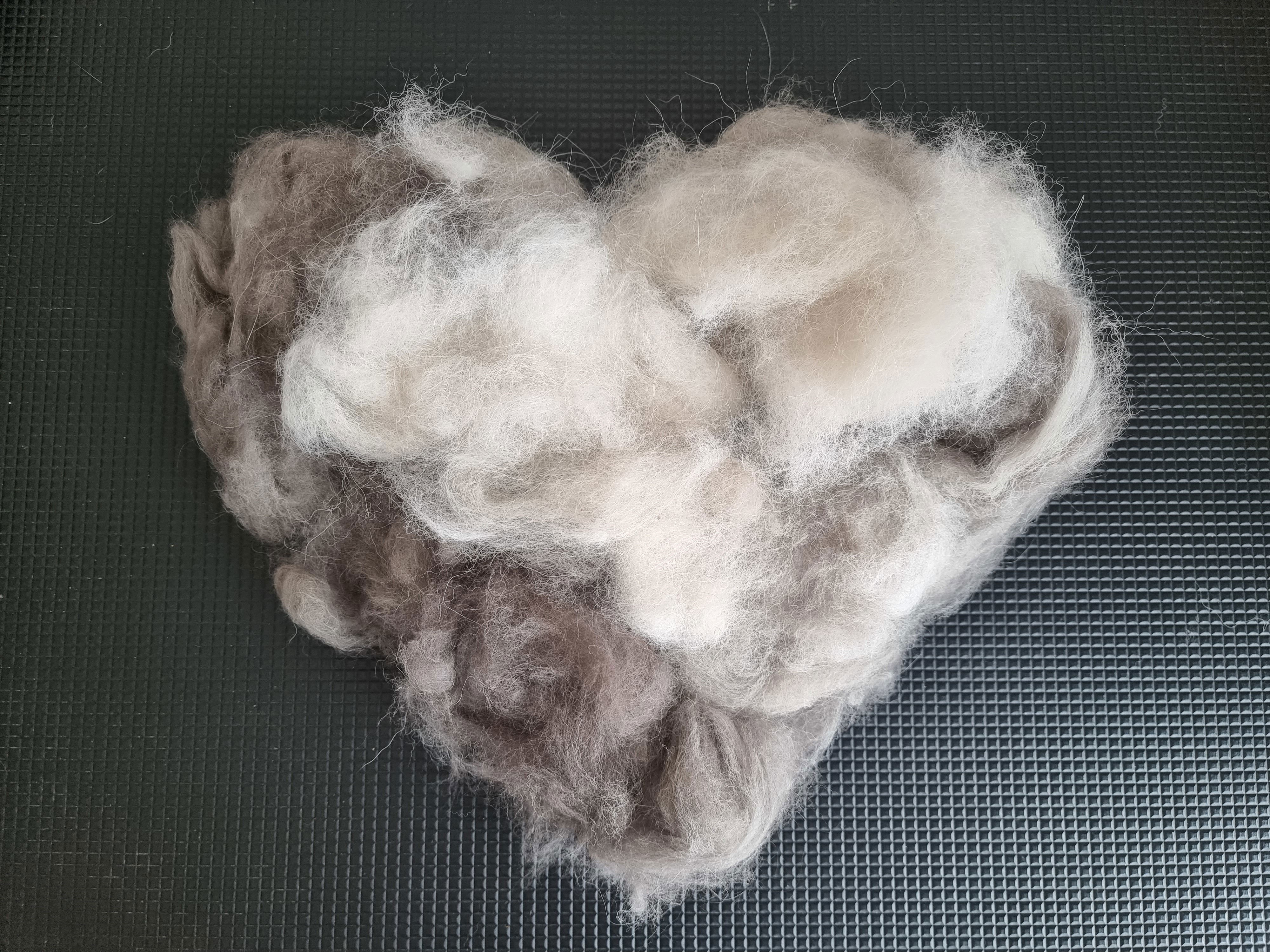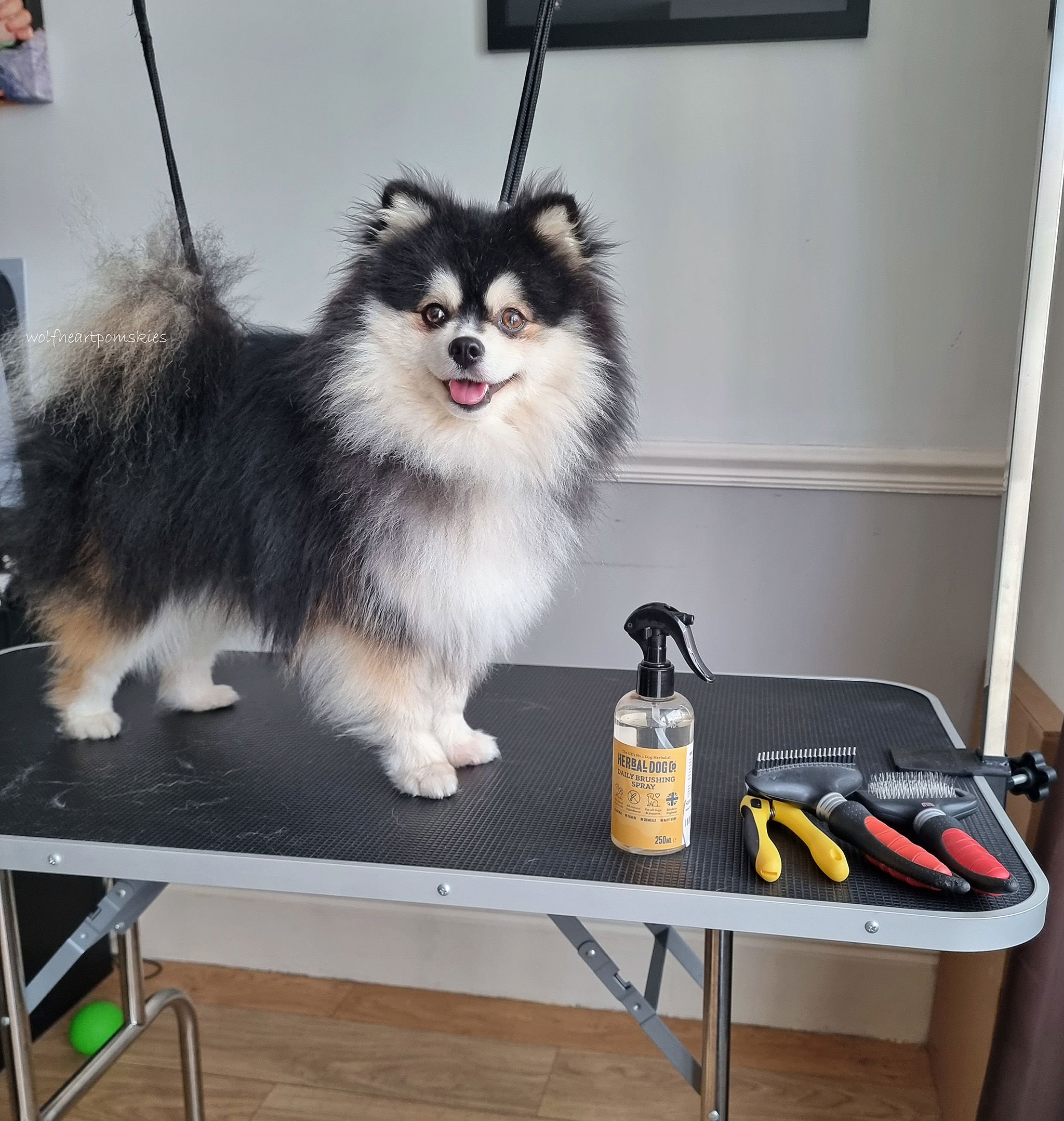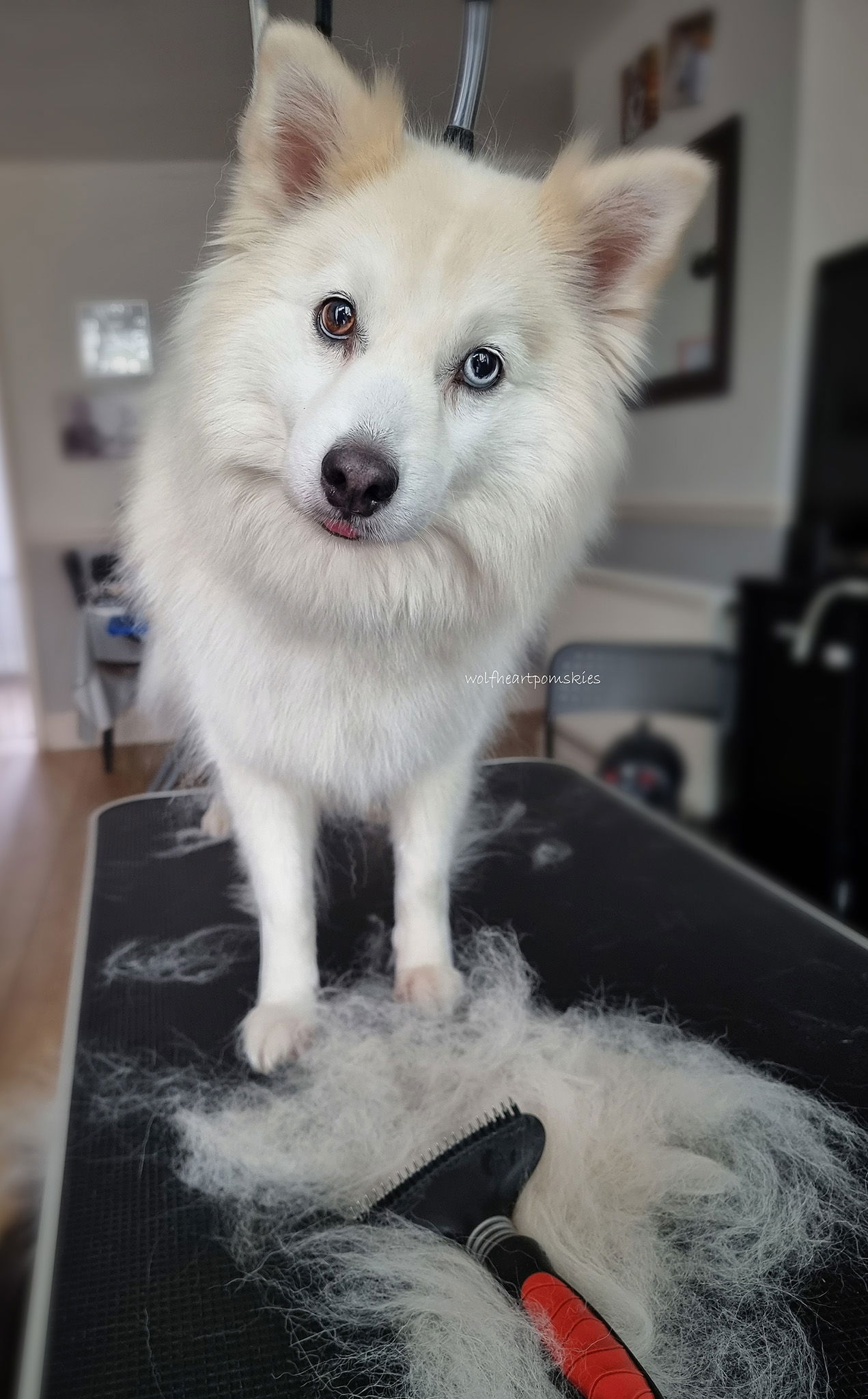Essentials:
-Undercoat rake (we use a Mikki rake, medium size)
-Slicker brush (we use a small)
-Blunt ended scissors (for long fur between toe pads, matts and any sanitary trims)
-Nail clippers
-Toothpaste and toothbrush
Optional extras:
-High velocity dryer/blaster
-Grooming table
-Detangling spray for woolly coats

The Pomsky Coat
Pomskies are double coated. The layer underneath is called the undercoat and serves to insulate their bodies. The top layer includes the guard hairs. They vary in length between the coat types and they serve to protect them from allergens and insects.
Why not to shave a Pomsky:
Before going on to grooming, I want to highlight that Pomskies should NEVER be shaved. Their double coat is designed to keep them warm in colder months and keep them cool during warmer months. In Spring, they shed to remove their thick, winter coat and prior to colder months, they will shed their thin, summer coat to make way for their thicker coat.
- Shaving a Pomsky (or any double coated breed) means you are removing a protective layer that protects them from the sun, from being scratched during play, from insects and irritants and it is removing an insulation layer.
- Shaving is likely to cause skin irritation.
- Dogs cool themselves down by panting and sweating via their paws.
- Shaving a double coat causes the fur to grow back irregularly and potentially causes more shedding.
- Do not use a furminator- they damage the guard hairs. There are other tools that are more effective and do not damage their coat.
On my woolly coated Pomskies, I trim the long fur in between their paw pads. In Winter, I leave it at a certain length to help them get a grip on icy floors. I regularly check their paws for any grit in the fur. The fur helps to insulate their paws when the floors get cold.
I rarely do sanitary trims. I love their coats and do not like to change how it naturally grows. I find I have to trim Emma's butt fluff otherwise it sits in her wee when she squats. I have to trim the armpit and inner thigh areas on Hendrix as it grows very quickly and matts easily. I have recently bought a new, natural detangling spray that I hope will prevent the matting.
I groom my Pomskies and husky one to two times a week and then every day to every 2 days when they shed.
Benefits of grooming regularly:
- Prevents matts
- Removes loose fur
- Stimulates the natural oils that protects their fur and brushing helps to distribute the oils.
- It can be a great bonding session
- It is an ideal time to do a full health check- checking their skin for sores, parasites, flakiness, to feel any new lumps or bumps, check their eyes, nose and mouth.
Consensual grooming
Consensual grooming is grooming with their consent. The groomer needs to be aware of what the dog is saying with their body language. There are some areas that they don’t feel comfortable being brushed and are likely to shift their weight away from the brush, lift their leg up, start lip-licking, flatten their ears or tuck their tail under their bodies.
I started grooming them by making positive associations with the table and then the brush. Only when they were comfortable with both then I started grooming them. I would praise them and use treats so they knew at every stage that this is something positive.
Pomskies need to be groomed regularly therefore making it an enjoyable experience from the start makes life a lot easier for them and for you.
I groom all my dog's myself because I find it therapeutic, it helps maintain our bond and I love seeing their freshly groomed coats.
I have made the grooming table a positive, safe space that the pack love to be on. If I say, “I need to get the grooming table out” or “it’s time for a groom” the pack gets excited and Hendrix runs to the folded grooming table and puts his paws on it.
The grooming table is optional but since getting mine, I wouldn’t want to be without it. There are so many benefits from them being stood up using the leads around the neck and their abdomen, they are at a good height so you don't get backache (or less likely), they get used to a table at that height which doubles up to make them feel safer on the vets table. Once they feel comfortable on the table, you can do a full health check and trim their nails.
High velocity dryer/blaster
I started using a high velocity dryer/blaster at the start of this year and I wish I bought one years ago. They cut my grooming sessions right down as the dryer removes the majority of the loose fur. They are brilliant to use when they shed as you can see all the fur fly out. This would have taken me over 2 hours to remove before and in 30 mins, the blaster removed it. Not only do they remove the loose fur, but you can clearly see the skin and check it as you go along. The dryers are very powerful and noisy which can be scary for dogs. With each pack member, I worked with them to create positive associations. I used to have a helper to offer treats especially when I dried certain areas to maintain the positivity. I recently noticed that Emma wags her tail when she sees the blaster which makes me smile.

Bathing
I bathe the Pomskies about 2 to 4 times a year and more if they get muddy. They do not need bathing often due to the natural oils in their fur. Bathing them too much will wash away those oils.
All of my puppies will be introduced to the grooming table, a variety of brushes, baths, the blaster, nail clippers. toothpaste and toothbrush as well as a thorough check up which will mimic what the vet does. I can create a solid, positive foundation to which puppy owners can build upon and make grooming easier and make their vet trips a positive experience.
Shedded fur has its uses.
As long as dogs haven't had a recent bath, or any worm/flea treatments within the last 2 weeks, fur/fluff can be left out for birds to take away and use it in their nests. It helps to keep baby birds warm and it is naturally waterproof therefore keeping them dry.
Shedded fur can help to clean up oil spills, be used to make yarn, used as a stuffing in toys and crafts, protect the garden from slugs and it can also deter creatures that may be naturally scared of dogs.

Case story- Hendrix
Upon getting Hendrix, I quickly discovered he had a lot of flaky skin that he found very itchy. I do not know if this was due to him being on kibble or if he hadn’t received regular grooms. It may also be a mixture of both.
After a few weeks on raw, regular grooms and adding proflax skin and coat to his food, his skin was flake free and he stopped scratching. If I didn’t see any improvements, I would have fed him 1 protein over a week or two to see if he was allergic to any of the proteins. The vets performing an allergy test would have been my last resort.

On his first groom, I went slow yet he was not happy at all. When trying to brush around his back legs, he growled and showed his teeth. I almost doubted myself but I worked with him and the grooming table making a lot of positive associations. If I came to a knotty area, I used detangling spray and went very slow. My goal was to not make any negative associations. The second he showed he was fed up and wanted to move away, I stopped grooming to leave it on a good note. I praised him at every stage in nice, soothing tones and finished telling him how much of a good boy he had been.
If someone told me at the very start that months later, he would wag his tail and run to the bath, I could bath him without help (and he would sit happily in the bath), that he would get excited and run to the grooming table when he heard key words, that he would happily stand still and be fully groomed and that he would ask to get up again when I had finished grooming him… I would never have believed it.
Case story- Emma, nearly 7 years old
Emma wasn’t from a good breeder and negative events affect her more so than my others.
A few years ago, a vet forced the kennel cough vaccine on Emma. This made a huge negative impact on her behaviour with the vet, vaccines, applying flea treatments and going near her mouth. She only goes to the vet once a year for boosters and I work with her every time. I am gradually seeing slightly more relaxed behaviour each time but I have to be the one to handle her.
For years, I have been unable to open Emma’s mouth. I have tried many methods going slow and creating positive associations but got nowhere.
After creating positive associations with the grooming table, I offered the finger dog toothbrush to Emma. She sniffed it- great start! I then applied toothpaste (Dorwest roast dinner) and she licked it. I then touched her muzzle and she was happy- inside I was thinking wow, this is massive for Emma.

The next session, I did the same and she was the same. I proceeded to touch her lips and she let me- no backing off or crying. I moved her lip slightly and again she let me. I didn’t dare do too much in case she suddenly got upset but after a few sessions, adding something in every time, I am now able to brush all of her teeth. This for me is a massive win and I have realised I can only do this on the grooming table. It has become her safe space.
I have yet to go to the vets since the work with the table so I am curious if she will be more relaxed on our next visit.
Claire 🐾